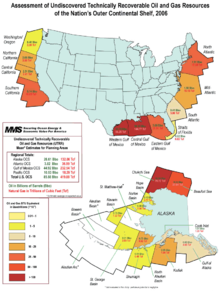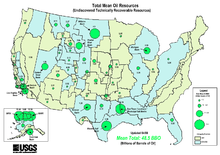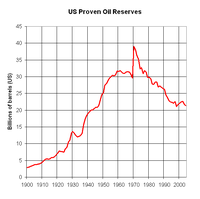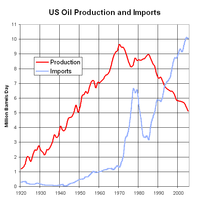- Oil reserves in the United States
-
Proven oil reserves in the United States are 21 billion barrels (3.3×109 m3), excluding the Strategic Petroleum Reserve. The U.S. Department of the Interior estimates the total volume of undiscovered, technically recoverable prospective resources in all areas of the United States, including the Federal Outer Continental Shelf, the 1002 area of the Arctic National Wildlife Refuge, the National Petroleum Reserve–Alaska, and the Bakken Formation, total 134 billion barrels (21.3×109 m3) of crude oil.[1][2] This excludes oil shale reserves, as there is no significant commercial production of oil from oil shale in the United States.
Contents
Proven reserves
United States proven oil reserves were 21 billion barrels (3.3×109 m3) in 2006 according to the Energy Information Administration.[3] This represents a decline of 46%, or 18 billion barrels (2.9×109 m3) from 39 billion barrels (6.2×109 m3) in 1970. U.S. crude production peaked in 1970 at 9.6 million barrels per day (1.53×106 m3/d), after the supergiant Prudhoe Bay field was found in Alaska. It has declined 47% to 5.1 million barrels per day (810×103 m3/d) by 2006.[4] United States crude oil production has been declining since reaching a smaller secondary production peak in 1988 (caused by Alaskan production). Total production of crude oil from 1970 through 2006 was 102 billion barrels (16.2×109 m3), or roughly five and a half times the decline in proved reserves.[5]
The reserves-to-production ratio (R/P) equaled 11.26 years in 2007. The ratio was 11.08 years in 1970. It hit a trough of 8.49 years in 1986 as oil pumped through the Alaska pipeline began to peak.[5]
Because of declining production and increasing demand, Net US imports of oil and petroleum products increased by 400% from 3.16 million barrels per day (502×103 m3/d) in 1970 to 12.04 million barrels per day (1.914×106 m3/d) in 2007. Its largest net suppliers of petroleum products in 2007 were Canada and Mexico, which supplied 2.2 and 1.3 Mbbl/d (350×103 and 210×103 m3/d), respectively.[6]
Net imports of oil and products account for nearly half of the US trade deficit. As of 2007, the US consumed 20.68m bbls of petroleum products/day and imported a net 12.04m bbls/day. The EIA reports the United States "Dependence on Net Petroleum Imports" as 58.2%.[7]
Strategic Petroleum Reserve
Main article: Strategic Petroleum ReserveThe United States maintains a Strategic Petroleum Reserve at four sites in the Gulf of Mexico, with a total capacity of 727 million barrels (115.6×106 m3) of crude oil. The maximum total withdrawal capability from the United States Strategic Petroleum Reserve is 4.4 million barrels (700,000 m3) per day. This is roughly 32% of US oil imports, or 75% of imports from OPEC.
 Estimates of Oil Resources in the Outer Continental Shelf [1]
Estimates of Oil Resources in the Outer Continental Shelf [1]
 Estimates of Onshore Oil Resources [2]
Estimates of Onshore Oil Resources [2]
Prospective resources
Services under the U.S. Department of the Interior estimate the total volume of undiscovered, technically recoverable oil in the United States to be roughly 134 billion barrels (2.13×1010 m3).[1][2] Over 1 million exploratory and developmental crude oil wells have already been drilled in the US since 1949.[8]
The Minerals Management Service (MMS) estimates the Federal Outer Continental Shelf (OCS) contains between 66.6 and 115.1 billion barrels (10.59×109 and 18.30×109 m3) of undiscovered technically recoverable crude oil, with a mean estimate of 85.9 billion barrels (13.66×109 m3). The Gulf of Mexico OCS ranks first with a mean estimate of 44.9 billion barrels (7.14×109 m3), followed by Alaska OCS with 38.8 billion barrels (6.17×109 m3). At $80/bbl crude prices, the MMS estimates that 70 billion barrels (11×109 m3) are economically recoverable. As of 2008, a total of about 574 million acres (2,320,000 km2) of the OCS are off-limits to leasing and development. The moratoria and presidential withdrawal cover about 85 percent of OCS area offshore the lower 48 states. The MMS estimates that the resources in OCS areas currently off limits to leasing and development total 17.8 billion barrels (2.83×109 m3)(mean estimate).[1]
The United States Geological Survey (USGS) estimates undiscovered technically recoverable crude oil onshore in United States to be 48.5 billion barrels (7.71×109 m3) [2] [9] The last comprehensive National Assessment was completed in 1995. Since 2000 the USGS has been re-assessing basins of the U.S. that are considered to be priorities for oil and gas resources. Since 2000, the USGS has re-assessed 22 priority basins, and has plans to re-assess 10 more basins. These 32 basins represent about 97% of the discovered and undiscovered oil and gas resources of the United States. The three areas considered to hold the most amount of oil are the coastal plain (1002) area of ANWR, the National Petroleum Reserve of Alaska, and the Bakken Formation.
In 1998, the USGS estimated that 1002 area of the Arctic National Wildlife Refuge contains a total of between 5.7 and 16.0 billion barrels (2.54×109 m3) of undiscovered, technically recoverable oil, with a mean estimate of 10.4 billion barrels (1.65×109 m3), of which 7.7 billion barrels (1.22×109 m3) falls within the Federal portion of the ANWR 1002 Area.[10] In May 2008 the EIA used this assessment to estimate the potential cumulative production of the 1002 area of ANWR to be a maximum of 4.3 billion barrels (680,000,000 m3) from 2018 to 2030. This estimate is a best case scenario of technically recoverable oil during the area's primary production years if legislation were passed in 2008 to allow drilling.[11]
A 2002 assessment concluded that the National Petroleum Reserve–Alaska contains between 6.7 and 15.0 billion barrels (2.38×109 m3) of oil, with a mean (expected) value of 10.6 billion barrels (1.69×109 m3). The quantity of undiscovered oil beneath Federal lands (excluding State and Native areas) is estimated to range between 5.9 and 13.2 BBO, with a mean value of 9.3 BBO. Most oil accumulations are expected to be of moderate size, on the order of 30 to 250 million barrels (40,000,000 m3) each. Large accumulations like the Prudhoe Bay oil field (whose ultimate recovery is approximately 13 billion barrels (2.1×109 m3)), are not expected to occur. The volumes of undiscovered, technically recoverable oil estimated for NPRA are similar to the volumes estimated for ANWR. However, because of differences in accumulation sizes (the ANWR study area is estimated to contain more accumulations in larger size classes) and differences in assessment area (the NPRA study area is more than 12 times larger than the ANWR study area), economically recoverable resources are different at low oil prices. But at market prices above $40 per barrel, estimates of economically recoverable oil for NPRA are similar to ANWR.[12]
In April 2008, the USGS released a report giving a new resource assessment of the Bakken Formation underlying portions of Montana and North Dakota. The USGS believes that with new horizontal drilling technology there is somewhere between 3.0 and 4.5 billion barrels (480×106 and 720×106 m3) of undiscovered, technically recoverable oil in this 200,000 square miles (520,000 km2) formation that was initially discovered in 1951. If accurate, this reassessment would make it the largest "continuous" oil accumulation (The USGS uses "continuous" to describe accumulations requiring extensive artificial fracturing to allow the oil to flow to the borehole) ever discovered in the U.S.[9] The formation is estimated to contain significantly more - figures in excess of 150 billion barrels (2.4×1010 m3) have been reported - but it is yet uncertain how much of this oil is recoverable using current technology. In 2011, Harold Hamm claimed that the recoverable share may reach 24 billion barrels (3.8×109 m3); this would mean that Bakken contains more extractable petroleum than all other known oil fields in the country, combined.[13][14]
Unconventional prospective resources
Oil shale
Main article: Oil shale reservesThe United States has the largest known deposits of oil shale in the world, according to the Bureau of Land Management and holds an estimated 2.175 trillion barrels (345.8 km3) of potentially recoverable oil.[15] Oil shale does not actually contain oil, but a waxy oil precursor known as kerogen. There is no significant commercial production of oil from oil shale in the United States.
See also
References
- ^ a b c d U.S. Department of the Interior, (MMS) (2006). "Assessment of Undiscovered Technically Recoverable Oil and Gas Resources of the Nation’s Outer Continental Shelf, 2006". Minerals Management Service. http://www.mms.gov/revaldiv/PDFs/2006NationalAssessmentBrochure.pdf. Retrieved 2008-08-16.
- ^ a b c d U.S. Department of the Interior, (USGS) (2007). "Comprehensive Resource Summary: Conventional, Continuous, Coal-bed Gas". United States Geological Survey. http://certmapper.cr.usgs.gov/data/noga00/natl/tabular/2007/summary_07.pdf. Retrieved 2008-08-16.
- ^ U.S. Energy Information Administration (EIA) - U.S. Government - U.S. Dept. of Energy. Total U.S. Proved Reserves of Crude Oil 1996-2006, Released Date: December 31, 2007
- ^ U.S. Energy Information Administration (EIA) - U.S. Government - U.S. Dept. of Energy, U.S. Petroleum Supply and Consumption 2005-2009, Date Published : July 8, 2008
- ^ a b Energy Information Agency, (EIA) (2008-07-23). "Crude Oil Production". U.S. Department of Energy. http://tonto.eia.doe.gov/dnav/pet/pet_crd_crpdn_adc_mbbl_a.htm. Retrieved 2007-11-11.
- ^ "Annual Energy Review (AER)". Official Energy Statistics from the U.S. Government. U.S. Energy Information Administration. April 24, 2008. http://www.eia.doe.gov/emeu/aer/txt/stb0507.xls. Retrieved 2008-08-14.
- ^ Energy Information Agency, (EIA) (2007). "Petroleum Basic Statistics". U.S. Department of Energy. http://www.eia.doe.gov/basics/quickoil.html. Retrieved 2008-08-17.
- ^ Energy Information Agency, (EIA) (2006). "Crude Oil and Natural Gas Exploratory and Development Wells, Selected Years, 1949-2005". U.S. Department of Energy. http://www.eia.doe.gov/emeu/aer/pdf/pages/sec4_11.pdf. Retrieved 2007-11-11.
- ^ a b U.S. Department of the Interior, (USGS) (April 10, 2008). "Comprehensive Resource Summary: Conventional, Continuous, Coal-bed Gas". United States Geological Survey. http://www.usgs.gov/newsroom/article.asp?ID=1911. Retrieved 2008-04-10.
- ^ United States Geological Survey, (USGS) (April 1998). "Arctic National Wildlife Refuge, 1002 Area, Petroleum Assessment, 1998, Including Economic Analysis". United States Geological Survey. http://pubs.usgs.gov/fs/fs-0028-01. Retrieved 2008-08-12.
- ^ Energy Information Agency, (EIA) (May 2008). "Analysis of Crude Oil Production in the Arctic National Wildlife Refuge". U.S. Department of Energy. http://www.eia.doe.gov/oiaf/servicerpt/anwr/pdf/sroiaf(2008)03.pdf. Retrieved 2008-06-27.
- ^ United States Geological Survey, (USGS) (2002). "U.S. Geological Survey 2002 Petroleum Resource Assessment of the National Petroleum Reserve in Alaska (NPRA)". United States Geological Survey. http://pubs.usgs.gov/fs/2002/fs045-02. Retrieved 2008-08-12.
- ^ "N.D. study estimates 167 billion barrels of oil in Bakken". http://bismarcktribune.com/news/state-and-regional/n-d-study-estimates-billion-barrels-of-oil-in-bakken/article_71ddd831-683a-50d4-a259-a6cb70c47ef6.html.
- ^ "CEO: 24 Billion Barrels of Oil in Bakken Shale". http://www.cnbc.com/id/44255518.
- ^ John R. Dyni (2005). "Geology and Resources of Some World Oil-Shale Deposits". Scientific Investigations Report 2005–5294. US Geological Survey. http://pubs.usgs.gov/sir/2005/5294/pdf/sir5294_508.pdf. Retrieved 2008-08-11.
Oil reserves by country Listing List of countries by proven oil reservesCountries Categories:- Energy in the United States
- Oil reserves by country
- Geology of the United States
Wikimedia Foundation. 2010.



